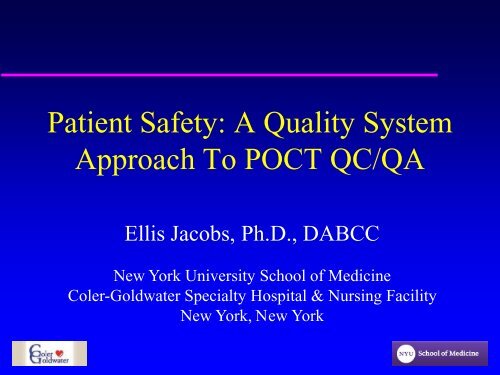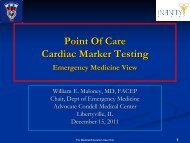A Quality System Approach To POCT - Whitehat
A Quality System Approach To POCT - Whitehat
A Quality System Approach To POCT - Whitehat
- No tags were found...
Create successful ePaper yourself
Turn your PDF publications into a flip-book with our unique Google optimized e-Paper software.
Point-of-Care TestingCharacteristicsA broad based process.Unrestricted to location,personnel or test menu.A collective, multidisciplinaryeffort.Simple to use technologyPotentially low volumetesting
<strong>POCT</strong> versus Central Lab TestingCentral Lab<strong>POCT</strong>Testing personnelPathologists,, PhDs,Med. LabTechnologistsNurses, other caregiversPrimary duties Laboratory testing Patient careKnows laboratory testing Extensive MinimalUnderstands instrument’squality checksExtensiveMinimalCan interpret QC data Yes Probably notSkills to resolve problems,troubleshootingYesRecognizes quality testing Yes Not necessarilyNo
Potential Analytes for <strong>POCT</strong>BilirubinBlood GasesBUNCardiac MarkersCBCChloesterol/TrigsDrugsFecal Occult BloodGastric Occult BloodGlucoseGram StainsHgB/HctHgB A1CInfectious DiseasesLactateNa, K, Ca ++ , Cl, Mg ++O 2 SatPlatelet FunctionPregnancyPT/PTT/ACTUrinarymicroalbumin/creatinineUrinalysis/Specific Gravity
Point-of-Care Tests (<strong>POCT</strong>) NOT considered laboratory testing– Breath alcohol– Continuous glucose monitors– Pulse oximeters– Transcutaneous bilirubinometers– Ex vivo ABG– Biosensor Technologies (monitors)
Trends in Healthcare Provision<strong>POCT</strong>LaboratoryHomePrimaryCareCentreCommunityTreatmentCentreLocalHospitalReferral/SpecialistHospital
The Truth about <strong>POCT</strong> <strong>POCT</strong> introduces an additional technology– Different precision– Biases– Unique interferences <strong>POCT</strong> results do not necessarily agree with corelaboratory results <strong>Quality</strong> concerns if manufacturers instructionsand controls are not performed as required Additional testing is ordered when <strong>POCT</strong> resultsdo not match core lab results or questions aboutthe quality of results present
Growth in <strong>POCT</strong>2008 Worldwide IVD Market -$42.1 Billion (46B in 2010)2008 Worldwide <strong>POCT</strong> Market -$13.1 Billion (31%)2010 Worldwide Professional<strong>POCT</strong> Market - $4 Billion ~10-12% annual growth
Moderators of <strong>POCT</strong> Growth <strong>Quality</strong> Assurance <strong>Quality</strong> Control - Matrix/Electronic Regulatory Requirements Record Keeping/Data Management Finances
What is <strong>Quality</strong> Laboratory– Delivery of test results within a specific timeframe with specifiedprecision and accuracy Physician– Reliable test results that meet medical needs PatientTHE CORRECT RESULT, ONTHE CORRECT PATIENT,REPORTED IN THE CORRECTTIMEFRAME TO EFFECTPATIENT MANAGEMENT– A test that tells the physician what is wrong Manufacturer– Stable test systems which perform within required accuracy andprecision specifications
<strong>Quality</strong> Issues There is no “perfect” device, otherwise we wouldall be using it. Any device can and will fail under the rightconditions. Any discussion of risk must start with what cango wrong with a test (errors). Laboratory tests are not foolproof.
<strong>Quality</strong> <strong>System</strong>Organizational structure, resources, policies,processes and procedures needed to implementquality management(ISO, NCCLS)In other words… all activities which contribute to qualityof testing, directly or indirectly.
<strong>Quality</strong> AssuranceAll planned and systematicactions necessary to provideadequate confidence that goodsor services will satisfy thecustomer’s needs.
POC Testing Knowledge FlowHealth CareProviderDeterminesNeed for DataData entryinto LISSampleObtainedSample ProcessedAt POCSampleReceived &Processed inLabSampleTransported<strong>To</strong> Satellite Lab
<strong>POCT</strong> <strong>Quality</strong> Assurance DilemmaDue to the rapid availability of resultswith <strong>POCT</strong>, data can often be seenand acted upon prior to any QAchecks or other external mechanismsfor assuring test results can be appliedto these systems.
What is RiskCombination of the probability ofoccurrence of harm and the severity ofthat harm (ISO/IEC Guide 51).
Risk AcceptabilitySeverity of HarmProbability of Harm Negligible Minor Serious Critical CatastrophicFrequent unacceptable unacceptable unacceptable unacceptable unacceptableProbable acceptable unacceptable unacceptable unacceptable unacceptableOccasional acceptable acceptable acceptable unacceptable unacceptableRemote acceptable acceptable acceptable acceptable unacceptableImprobable acceptable acceptable acceptable acceptable acceptableCLSI. Laboratory <strong>Quality</strong> Control Based on RiskManagement; Approved Guideline. EP23-A.Wayne, PA: Clinical and Laboratory StandardsInstitute; 2011.
<strong>Quality</strong> Control Operational techniques and activities usedto fulfill requirements for quality (ISO) Internal quality control (IQC) – set ofprocedures for continuously assessinglaboratory work and the emergent results;immediate effect, should actually controlrelease of results (WHO, 1981)
Process to Develop and Maintain (CQI)a <strong>Quality</strong> Control Plan (QCP)MEASURING SYSTEMINFORMATIONMedicalRequirements forthe Test ResultsRegulatory andAccreditationRequirementsMeasuring <strong>System</strong> Information● Provided by the Manufacturer● Obtained by the LaboratoryInformation AboutHealth Care andTest Site SettingPROCESSRisk AssessmentCorrectiveandPreventiveAction andContinualImprovementOUTPUT<strong>Quality</strong> Control PlanPROCESSPostimplementation MonitoringCLSI. Laboratory <strong>Quality</strong> Control Based on Risk Management;Approved Guideline. EP23-A. Wayne, PA: Clinical andLaboratory Standards Institute; 2011.
Key Processes in the LaboratoryPath of WorkflowPreexamination(Preanalytical)Processes• Examinationordering• Sample collection andlabeling• Sample transport• Sample receipt andaccessioning• Preexaminationsample processingExamination(Analytical)Processes• Examination• Results review andfollow-up• Medical reviewPostexamination(Postanalytical)Processes• Results reporting• Results archiving• Sample archiving• Charging forexaminations, whereapplicableCLSI. Laboratory Documents: Development and Control;Approved Guideline—Fifth Edition. GP02-A5. Wayne, PA: Clinicaland Laboratory Standards Institute; 2006.
<strong>Quality</strong> <strong>System</strong> HierarchyTQM<strong>Quality</strong>Management<strong>Quality</strong> <strong>System</strong>s<strong>Quality</strong> Assurance<strong>Quality</strong> Control
<strong>POCT</strong> as a TQM Project Multidisciplinary team approach Looking at entire system, rather thanindividual performance On-going evaluation & refinement(CQI) Cost savings Improvement in delivery of criticallaboratory services
<strong>Quality</strong> Management <strong>System</strong> ModelLaboratory’s Path of WorklowPreanalytical Analytical PostanalyticalQSEs encompass the entire path
<strong>Quality</strong> Service Essentials (QSEs)Facilities&SafetyDocuments&RecordsEquipmentCustomerServiceInformationManagementProcessControl<strong>Quality</strong><strong>System</strong>ProcessImprovementAssessmentsExternal &InternalOrganizationPersonnelPurchasing&InventoryOccurrenceManagement
<strong>Quality</strong> Service Essentials (QSEs)EquipmentProcessImprovementFacilities&SafetyTheLabOrganizationCustomerServiceMeasurmentOccurrenceManagementPersonnelPurchasing&InventoryDocuments&RecordsAssessmentsExternal & InternalTheWorkProcessControlInformationManagement
<strong>Quality</strong> of Health Care in U.S. Institute of Medicine– Medical errors cause 44,000 to 98,000 deaths eachyear» Equivalent to 200 deaths each day in airline crashes» Fifth leading cause of death in U.S.Ahead of diabetes, breast cancer, HIV» Lab testing certainly contributes to deathsLab is looking for built-in safeguards to preventerrors<strong>To</strong> Err is Human: Building a Safer Health <strong>System</strong>.Washington, DC, National Academy Press; 2000
Laboratory TestingPotential Sources of ErrorspatientTransmitresultRecordresultPreparerequestformPhlebotomydoctorReportresultTransportsampleValidateresult<strong>Quality</strong>controlAnalysesamplePreparesampleRegistersample
Sources of Testing Error1997 2007Preanalytical 68% 62%Analytical 13% 15%Postanalytical 19% 23%Plebani M, Carraro P, Clin Chem 1997;43:1348-1351Carraro P, Plebani M, Clin Chem 2007;53;1338-1342
Potential Impact of <strong>POCT</strong> onLaboratory ErrorsPre-AnalyticalPatient IdentificationSpecimen IdentificationImproper result validation (QC)Post-AnalyticalRoutingExcessive turn-around timeAnalyticalMethod CalibrationInterferencesResults out of measurement range<strong>Quality</strong> Assessment (EQA/PT)
Fishbone Diagram of PotentialFailure Modes1Samples2Operator4Laboratory EnvironmentSample Integrity- Lipemia- Hemolysis- Interfering subtances- Clotting- Incorrect tubeSample Presentation- Bubbles- Inadequate volumeIdentify Potential HazardsOperator Capacity- Training- CompetencyReagent Degradation- Shipping- Storage- Used past expiration- Preparation<strong>Quality</strong> Control Material Degradation- Shipping- Storage- Used past expiration- PreparationOperator staffing- Short staffing- Correct staffing3ReagentsAtmospheric Environment- Dust- Temperature- HumidityCalibrator Degradation- Shipping- Storage- Used past expiration- PreparationUtility Environment- Electrical- Water quality- Pressure5Measuring<strong>System</strong>Instrument Failure- Software failure- Optics drift- Electronic instabilityIncorrect Test ResultInadequate Instrument Maintenance- Dirty optics- Contamination- ScratchesCLSI. Laboratory <strong>Quality</strong> Control Based on Risk Management;Approved Guideline. EP23-A. Wayne, PA: Clinical andLaboratory Standards Institute; 2011.
Sources of <strong>Quality</strong> Errors in <strong>POCT</strong>Postanalytical3%Analytical65%Preanalytical32%N = 225
<strong>POCT</strong> <strong>Quality</strong> Errors by TestTest Type # of Tests # of defects % of defectsBlood gas/electrolytes 22,687 119 0.52Blood gas/electrolytes/troponin I5,809 10 0.17Pregnancy 8,879 14 0.158Glucose 30,389 71 0.02Drugs of Abuse 247 1 0.4Hb A1c 1,236 8 0.65Urinalysis 64,370 2 0.003Blood Ketones 1,087 0 0O’Kane M, et al, Clin Chem 2011;57:1267-1271
Impact of <strong>POCT</strong> ErrorsScoreAcutaln (%)Potentialn (%)1 116 (51.2) 6 (2.7)2 109 (48.4) 175 (77.8)3 0 (0) 3 (1.3)4 0 (0) 33 (14.7)5 0 (0) 8(3.6)
<strong>POCT</strong> & Patient Safety:<strong>Quality</strong> Testing Criteria Correct test ordered Correct patient Correct time for collection Correct specimen and processing Correct (accurate) test result Correct patient record Correct clinical interpretation of <strong>POCT</strong> result(s) Correct and timely clinical response
Best Practices for Glucose <strong>POCT</strong> Positive Patient ID- two identifiers Operator Certification Regular Calibration & QC Use Fresh Reagents Prevent Reagent Contamination Prevent Substance Interference Prevent Blood Sampling Errors
Evolution of <strong>POCT</strong>ManualAutomationA process or system operating automaticallyAutonomationIntelligent automation – detects single defective operation andautomatically stopsEhrmeyer S, Lassig R. Clin Chem Lab Med 2007;45(6):766-773
Managing Sources of <strong>POCT</strong> ErrorsDesigned out of the productTested forWarned about
Evolution of Glucose <strong>POCT</strong>TechnologyManual Testing Incorrect sample amount Incorrect reagent amount Incorrect mixing Wrong position of testingdevice Wrong wait time Color blindness
Evolution of Glucose <strong>POCT</strong>TechnologyManual Methods1 st /2 nd Generation Instruments Wipe/Wipeless technology Operator ID / Patient ID Reduced operatorintervention Operator prompts Check on reagent viability QC lock-outs Rudimentary DataManagement
Evolution of Glucose <strong>POCT</strong>TechnologyManual Tests1 st /2 nd Generation InstrumentsCurrent Technology Electrochemical Technology Ability to use universalspecimen types Extended linearity Minimally Invasive Technology(
Patient/Sample Identifcation Pre-barcodedarterial syringe forpositive patientidentification Establishes andMaintains SampleID throughouttesting process
Preanalytical Error Reduction Reduced Analytical Risks– Glucose-specific strip technology– Individually foil wrapped and bar-codedstrips –» reduces risk of contamination» assure fresh reagents for each test» only approved lots can be used Reduced Risk of Sampling Errors– Test begins when adequate sample isdetected, reducing risk of short-samplingand over-sampling errors
Unit use and <strong>POCT</strong> devices It is often suggested that QC has no rolein a unit use device because…– QC of a single unit (good or bad result) doesnot inform about other units [same argumentwould apply to non <strong>POCT</strong> analyzers in mainlab that use discrete (unit use) reagent packs]– IMS fulfills QC role in unit use devices Unit use and continuous flow systemsare not that different
Characteristics of Unit-Use Test The container where the test is performed isalways discarded after each test. Reagents, calibrators, and wash solutionsare typically segregated as one test. Thereis no interaction of reagents, calibrators, andwash solutions from test to test.
Nature of QC Procedures Use of electronic checks, including anyinstrument software features that serve aserror detection or prevention mechanisms Use and number of surrogate samples,where appropriate, to be included as part ofthe QC procedure Testing of controls that are engineered intothe test system
Centrifugal Analyzer – IntegratedSurogate Controls
Integrated Surrogate ControlQuantitative Immunochromatography
Surrogate QC doesn’t detectall errors
Non-Surrogate Sample QCIncludes all forms of quality control other than themeasurement of a surrogate sample, usuallyintegrated into the device– electronic QC (which simulates signalselectronically), ex. i-STAT– automated procedural controls (which ensure thatcertain steps of the procedure occur appropriately),ex. Immunochromatography test kits– automated internal quality controls (which may, forexample, ensure the quality of a raw signal), ex.– diagnostic pattern recognition systems, ex. GEM iQM
Immunochromatography – UrineDipstick
Blood Gas Analyzer - IMSContinuously monitors all criticalcomponents of blood gas testing in real timeto assure accurate resultsAutomatically assures that each test meetsdemanding quality specificationsImmediately detects, corrects and documentserrorsEliminates labor and material costsassociated with traditional QCAssures that optimal quality controlprotocols are followed at all times,regardless of operator training
Internal monitoring systems(IMS)IMS are a collection of hardware andsoftware that detect errors and prevent theeffect of the error from occurring– Example: Noise in the signal of a patientsample is detected, the result is flagged and notreportedIMS are not new – although alwaysimproved, they have been in systems forover 30 years
Internal monitoring systems Internal monitoring systems don’tdetect all errors, because– Complexity of instrument systemsprevents perfect failure mode models– There is management pressure to releasenew products quickly– There is insufficient knowledge to“design things right the first time”
Non-Surrogate QC and QCSurrogate andNon-Surrogate QC are not completelyredundant do not detect allerrorsSurrogate QCNon SurrogateQC
Thinking in the <strong>POCT</strong> BoxIncorrectIdentificationSampleHandling/TransportEquipmentMalfunctionImproperDataEntryInsufficientSamplePre Analytical62%Analytical15%Post Analytical23%ReportingorAnalysisIncorrectSampleSampleConditionSample Mix-Ups/InterferencesDelayedTurn-aroundTimeAs autononmation reduces errors in the box,further reductions must occur outside the box.
Thinking Outside the <strong>POCT</strong> BoxPre-pre: Phsician must consider» What <strong>POCT</strong> is available?» What <strong>POCT</strong> will best serve the patient?» Will an immediate answer improve the patient’soutcome? Post-post: Is the Physician?» Receptive to using an immediate <strong>POCT</strong> result» Able to interpret result in the patient’s context» Amenable to initiating an immediate response
Critical Factors in QC Decisions QC must be able to detect mistakes to enableimmediate correction Risks and costs must be weighed QC is only one part of the quality control plan / qualitymanagement system Not all laboratories have the same competencies andorganization Science and common sense must converge
<strong>Quality</strong> Control Plan Summarizes the potential errors for a device and how the lab willaddress them. Can be high level or very detailed - depends on the device, thelaboratory, and the clinical application and can vary from lab to lab. Is scientifically based. It depends on the extent to which thedevice’s features or actions achieve their intended purpose and thelaboratory’s expectations for ensuring quality test results. Once implemented, is monitored for effectiveness and may bemodified to maintain risk at a clinically acceptable level.
The Problem with Pedestals
QUESTIONS





